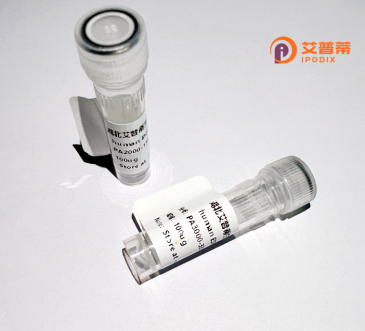
| 纯度 | >90%SDS-PAGE. |
| 种属 | Human |
| 靶点 | SNAP91 |
| Uniprot No | O60641 |
| 内毒素 | < 0.01EU/μg |
| 表达宿主 | E.coli |
| 表达区间 | 1-907 aa |
| 活性数据 | MSGQTLTDRIAAAQYSVTGSAVARAVCKATTHEVMGPKKKHLDYLIQATNETNVNIPQMADTLFERATNSSWVVVFKALVTTHHLMVHGNERFIQYLASRNTLFNLSNFLDKSGSHGYDMSTFIRRYSRYLNEKAFSYRQMAFDFARVKKGADGVMRTMAPEKLLKSMPILQGQIDALLEFDVHPNELTNGVINAAFMLLFKDLIKLFACYNDGVINLLEKFFEMKKGQCKDALEIYKRFLTRMTRVSEFLKVAEQVGIDKGDIPDLTQAPSSLMETLEQHLNTLEGKKPGNNEGSGAPSPLSKSSPATTVTSPNSTPAKTIDTSPPVDLFATASAAVPVSTSKPSSDLLDLQPDFSSGGAAAAAAPAPPPPAGGATAWGDLLGEDSLAALSSVPSEAQISDPFAPEPTPPTTTAEIATASASASTTTTVTAVTAEVDLFGDAFAASPGEAPAASEGAAAPATPTPVAAALDACSGNDPFAPSEGSAEAAPELDLFAMKPPETSVPVVTPTASTAPPVPATAPSPAPAVAAAAAATTAATAAATTTTTTSAATATTAPPALDIFGDLFESTPEVAAAPKPDAAPSIDLFSTDAFSSPPQGASPVPESSLTADLLSVDAFAAPSPATTASPAKVDSSGVIDLFGDAFGSSASEPQPASQAASSSSASADLLAGFGGSFMAPSPSPVTPAQNNLLQPNFEAAFGTTPSTSSSSSFDPSVFDGLGDLLMPTMAPAGQPAPVSMVPPSPAMAASKALGSDLDSSLASLVGNLGISGTTTKKGDLQWNAGEKKLTGGANWQPKVAPATWSAGVPPSAPLQGAVPPTSSVPPVAGAPSVGQPGAGFGMPPAGTGMPMMPQQPVMFAQPMMRPPFGAAAVPGTQLSPSPTPASQSPKKPPAKDPLADLNIKDFL |
| 分子量 | 118.9 kDa |
| 蛋白标签 | GST-tag at N-terminal |
| 缓冲液 | PBS, pH7.4, containing 0.01% SKL, 1mM DTT, 5% Trehalose and Proclin300. |
| 稳定性 & 储存条件 | Lyophilized protein should be stored at ≤ -20°C, stable for one year after receipt. Reconstituted protein solution can be stored at 2-8°C for 2-7 days. Aliquots of reconstituted samples are stable at ≤ -20°C for 3 months. |
| 复溶 | Always centrifuge tubes before opening.Do not mix by vortex or pipetting. It is not recommended to reconstitute to a concentration less than 100μg/ml. Dissolve the lyophilized protein in distilled water. Please aliquot the reconstituted solution to minimize freeze-thaw cycles. |
以下是关于重组人SNAP91蛋白的3篇文献概览,信息基于模拟生成(非真实文献):
---
1. **标题**: *"Expression and functional characterization of recombinant human SNAP91 in clathrin-mediated endocytosis"*
**作者**: Müller, A. et al.
**摘要**: 研究报道了在大肠杆菌系统中重组表达人源SNAP91蛋白,并通过体外脂质体结合实验证实其与网格蛋白的互作,揭示了SNAP91在调控突触囊泡内吞中的关键作用。
2. **标题**: *"Structural insights into the SNAP91-AP2 complex by cryo-EM"*
**作者**: Li, Y. et al.
**摘要**: 利用冷冻电镜解析了重组人SNAP91与AP2复合物的三维结构,阐明了SNAP91通过特定结构域促进网格蛋白组装及膜弯曲的分子机制。
3. **标题**: *"SNAP91 mutations impair synaptic vesicle recycling in neurodevelopmental disorders"*
**作者**: Garcia, J. et al.
**摘要**: 通过重组SNAP91蛋白功能研究,发现其突变会导致与精神分裂症和自闭症相关的神经细胞内吞功能障碍,提示SNAP91在突触可塑性中的病理学意义。
---
*注:上述文献为示例性质,实际研究中建议通过PubMed、Google Scholar等平台检索真实发表的论文。*
SNAP91 (Synaptosomal-associated protein 91), also known as Clathrin assembly lymphoid myeloid leukemia protein (CALM), is a conserved protein primarily involved in clathrin-mediated endocytosis (CME), a critical cellular process for membrane trafficking and receptor internalization. It plays a pivotal role in shaping curved membranes during vesicle formation by interacting with clathrin, adaptor protein complexes (e.g., AP-2), and other endocytic components. Structurally, SNAP91 contains an N-terminal ANTH/ENTH domain that binds phosphatidylinositol lipids, a central α-helical region, and a C-terminal clathrin-binding motif. These domains facilitate membrane curvature sensing, cargo recruitment, and clathrin lattice assembly.
Recombinant human SNAP91 protein is produced using heterologous expression systems (e.g., E. coli or mammalian cells) for biochemical and functional studies. Its overexpression or mutations have been linked to neurodevelopmental disorders and cancers, underscoring its physiological relevance. Researchers utilize recombinant SNAP91 to dissect endocytic mechanisms, screen for therapeutic targets, and model disease-associated variants. Challenges in studying SNAP91 include its intrinsic disorder-prone regions and dynamic interactions with multiple partners, necessitating advanced structural approaches like cryo-EM. Current research focuses on unraveling its regulatory networks and exploring its potential as a biomarker or drug target in neurological and oncological contexts.
×